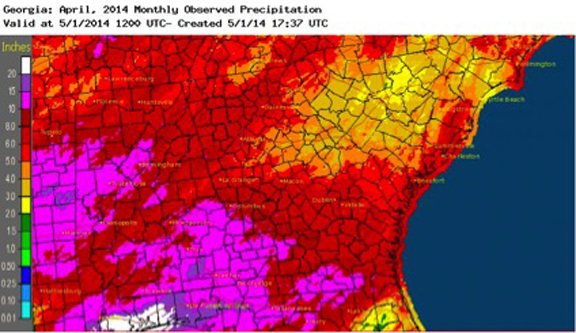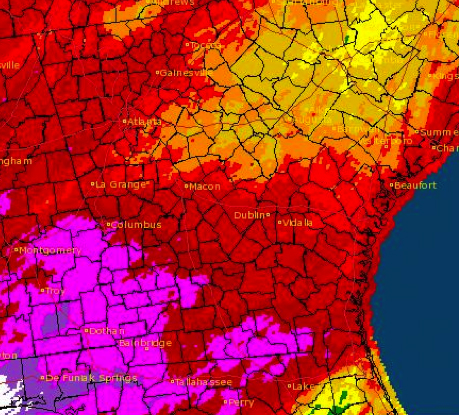April was significantly wetter than normal across most of the state, which recharged soil moisture but delayed planting of some summer crops.
This was the fourth wettest April in Columbus in 67 years; the last time it was this wet was 1979 when 10.69 inches. It was the fifth wettest April for Macon in 122 years; the last time it was this wet was 1938 with 10.25 inches. It was also the ninth wettest year in Savannah in 78 years of record.
Several other daily precipitation records were also set in April. Atlanta received 2.46 inches on April 7, beating the old record of 2.38 inches set in 1973. Alma received 2.52 inches, also on April 7, to surpass 1.59 inches from 1992. Two inches fell there on April 18, surpassing the old record of 1.04 inches set in 1969. Brunswick received 3.11 inches on April 18, much more than the old record amount of 0.72 inches set in 1953.
The highest monthly total precipitation from National Weather Service reporting stations was 9.3 inches in Columbus (5.75 inches above normal) and the lowest was in Athens at 4.17 inches (1.02 inches above normal). Atlanta received 5.9 inches (2.54 above normal), Macon received 7.46 inches (4.50 above normal), Alma received 7.66 inches (4.85 above normal), Augusta received 4.59 inches (1.75 above normal), Brunswick received 7.92 inches (5.43 above normal) and Savannah received 5.55 inches (2.48 above normal).
The highest single-day rainfall reported from the Community Collaborative Rain, Hall and Snow network was 5.14 inches near Manor in Ware County on April 8. Two other CoCoRaHS observers in Waycross reported 4.9 and 4.62 inches on the same day. The highest monthly total rainfall was 14.65 inches, observed 13 miles east-northeast of Fort Gaines in Clay County, followed by 12.13 inches measured northwest of Albany in Lee County.
The University of Georgia Automated Environmental Monitoring Network station in Donalsonville (Seminole County) reported 23.54 inches for the month, including 5.93 inches on April 7 alone.
Despite the wet weather, temperatures hovered around normal across the state.
In Atlanta, the monthly average temperature was 62.7 degrees F (0.7 degrees above normal); in Athens it was 62.3 degrees (0.6 above normal); in Columbus it was 64.4 degrees (0.2 below normal); in Macon it was 63 degrees (0.4 below normal); in Savannah it was 68.1 degrees (2.5 above normal); in Brunswick it was 67.3 degrees (0.8 above normal); in Alma it was 65.8 degrees (0.4 below normal) and in Augusta it was 63.2 degrees (0.5 above normal).
In addition to wet and temperate weather, April saw two waves of severe weather across Georgia.
The first round occurred on April 7. Observers reported two tornadoes and damaging winds after a strong cold front came through. The two EF1 tornadoes were observed in Ocilla in Irwin County and Lowry, 8 miles northwest of Griffin in Spalding County. Three people were injured. A report on this flood and severe weather event can be found at www.srh.noaa.gov/ffc/?n=20140407_flooding_tornado.
The second round of severe weather occurred April 28 in the wake of another strong front. Two tornadoes also occurred during this event, including an EF2 storm that moved from Troup County to Heard County. The second, an EF1 storm in Whitfield County, destroyed a chicken house and killed 16,000 chickens before crossing into Tennessee.
In addition, a severe wind event associated with a “wake low” on April 30 caused strong wind gusts across central Georgia following a squall line. One man was killed in Athens when a tree limb fell on his van, and several others were injured. Many trees and power lines were blown down, causing scattered power outages and a few school closings due to the lack of power. A description of the storm can be found at www.srh.noaa.gov/ffc/?n=wakelow20140430.
More news and information about the intersection of climate and agriculture can be found at blog.extension.uga.edu/climate/.








